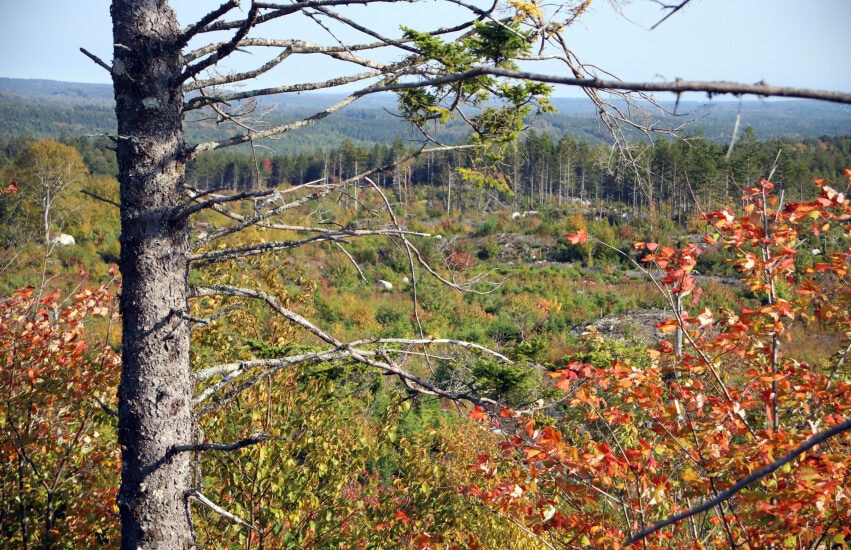
KJIPUKTUK (Halifax) – Forests are not merely carbon sinks, nor are they side characters in a climatic drama, quietly soaking up carbon while us cocky apes steer the destiny of the planet. They are dynamic, unruly, and just a little bit weird, and Canadian forests in particular have a long and complicated relationship with our atmosphere, absorbing carbon but also producing it, defying easy interpretations and demanding, above all, our respect and attention.
They grow, locking carbon in their tissues and soils in roughly equal measure, but they also respire, burning the sugars generated from photosynthesis in order to maintain their growing bodies, exhaling some of that carbon back into the atmosphere. They discard organic matter which is worked into the soils by bacteria, fungi and roots, piling carbon below a little quicker than it decomposes. Under their canopies blossom sub-canopies, bushes, mosses, lichens, ferns and flowers, birds, moose, black bears and Rove beetles, storing more carbon still until the next hurricane, the next forest fire, the next infestation of destructive insects wipes the slate clean, reducing the hopeless complexities of forest ecology once again to their elemental particles.
“They’re always recovering from something,” said Dr Nigel Roulet, chair of McGill University’s department of geology.
His point is that our forests are less of an unambiguous carbon sink and more of a revolving door, balancing growth and decay to keep reliable sums of carbon locked in the biosphere rather than the atmosphere. They are always growing, always dying, always recovering, but taken as a whole, they are a reservoir, growing one century, shrinking the next, but always keeping some spectacular mass of carbon locked in living biomass.
As recently as the 1990s, Canada’s managed forests (about 65 per cent of our total forested lands) were sequestering over 100 net megatonnes of carbon annually, with growth exceeding decay consistently and on a national level, but that’s changed. In the last decade especially the balance has tipped in favour of decay, as forest fires and forestry have emitted much more carbon than was absorbed. According to the National Inventory Report published last year, Canada’s managed forests emitted a net 240 megatonnes in 2018 alone. That is a devastating sum.
It’s a startling notion that Canada’s forests are, at this most unstable moment in human history, one of our nation’s largest emitters, twisted by industry and unseasonal warmth into surrendering more carbon than is absorbed, but we have some say over growth and decay, and need to exercise that power as intelligently as possible. We need to understand the motion of carbon through forests, and manage appropriately while there’s still something to manage.
Theoretical maximum
Imagine, if you will, an abandoned potato field, its soils poor, its owner absent. Plant a few trees or allow neighbouring trees to seed in and a new forest will begin explosively. As described by Dr Roulet, the young, early successional trees vying for space in this new frontier will scramble frantically skyward, clambering over each other for space and sunlight, gasping for carbon to fill out their tissues. In fact, when it comes to the speedy sequestration of carbon, Dr Roulet said there’s no beating the first 60-100 years of a forest’s scrappy life, which makes sense. The individual trees are not dedicating much energy to maintenance or the careful accumulation of resources. They are rushing, belligerently, to outpace and outgrow the rambunctious spruce to their right and left. Walk into a regrowing forest, knocked down by hurricane winds or a recent clearcut, and you’ll see immediately the unforgiving scrum which defines the early years of any given forest. Grow or die is their mantra, and walking through is hazardous to the eyes and shins.

The middle-aged woods which follow are very different beasts. The winners have been crowned – maybe a mess of trembling aspen standing over stubborn white spruce and red maple – and sequestration slows. The individual trees, which at this point have earned their place in the canopy, begin shifting some of their energies to maintenance rather than growth, and so a good portion of the carbon they absorb through photosynthesis, something like 60-70 percent, is re-emitted through respiration. They are still growing, still locking away carbon, but giving more of it back than they could previously afford. The forest diversifies as aspen, spruce and maple making room for birch, pine and hemlock, and the compounding maturities of various trees form habitat for more species still, pulling down carbon slowly in a patient spectacle of succession.
Then there is soil, the downtrodden hero of our imagined forest. Soils store carbon in several ways – in chemical bonds with available carbonates, in the structures of bacterial communities, but chiefly as soil organic matter, the decomposing piles of dead biomass left over from the raising of forests. Discarded leaves, barks and branches, failed bushes and fallen birds, wilting flowers and dropped apple cores, all contribute to soil organic matter, some broken down quickly by the aforementioned community of bacteria and releasing carbon in a matter of months, others slowly, like the hardy tissues of dead spruce, clinging to their toughness and texture for years or decades. Soils build slowly, but under natural conditions, forests deposit more organic matter than bacteria can possibly break down, resulting in a net sequestration remarkably resilient to the passage of time.
There are soils in the Boreal which, according to Dr Roulet, are in excess of 3,000 years old, several times older than the forests on top of them. Even in the case of massive canopy fires – the most common disturbance in the Boreal – trees might be cleansed, but soils remain relatively intact, unless of course the inferno burns them directly. Soils are also broken down by bacteria more quickly when warmed by direct sunlight in the case of a clearcut, leaking carbon for the following decade until they’re once again sheltered under regrowth. Erosion also doesn’t help.
It varies a little from one forest type to another, but in Canada, there’s roughly as much carbon stored in forest soils as in forests themselves. This is extraordinary, and means that no conversation about forests and carbon can be complete without the caveat of soil.
If undisturbed for centuries, our potato field will become a climax forest, reaching a theoretical peak at which it holds maximum biomass, maximum diversity, maximum carbon, unable to grow and unwilling to shrink. Growth and decay are roughly equal, and so our forest slips into a natural carbon neutrality. If it crosses your mind that such climax forests should be cut down to make room for younger woods hungrier for carbon, then you haven’t been listening. A climax forest has already done exactly what we needed it to do – remove as much carbon from the atmosphere as biologically practical, and hold that carbon with every fibre of its being, for centuries or millennia. Cutting such forests would mean resetting the process, throwing open the vault and spilling its treasures onto the street. Climax forests aren’t the sink. They are the reservoir.
You might have noticed the word “theoretical” in the previous paragraph. That was exactly the word used by Dr Roulet, and it’s well chosen. Only in theory will maturing forests reach a point of emitting as much carbon as they absorb, aging into carbon neutrality and retiring from active sequestration, because such a forest has never actually been observed. Even the most ancient of Canada’s forests are still putting away carbon, because they’re always recovering from something. Always.
The thoughtful axe
So how do we cut them down? I’ve met too many intelligent and creative foresters and enjoy too many of their products – namely my house – to suggest that we shouldn’t cut down trees. In fact, the sustainable use of natural resources is a subject I follow with interest, and trees, even forests, fit neatly into that category. We need forestry – its ingenuity, its products – but when any industry applies its craft without considering the abject necessities of all life, like biodiversity, water and air quality, public use, carbon sequestration and the continuity of industry, I lose all patience. The question isn’t whether or not to cut. The question is how to cut, where and when.

With respect to carbon, the answer to this question has several parts, suggested to me by Dr Jim Fyles, a retired forest ecologist from McGill University. The first is to increase the average age of our nation’s forests. The longer they grow uninterrupted, the more carbon they sequester, and on a large enough scale, that sequestration is significant, reminiscent of the 100 megatonnes annually in the 1990s. But forests put on biomass more slowly after their initial 60-100 year spirt, so, economically, foresters are encouraged to cut around this time, capitalizing on this hasty growth and keeping forests perpetually young. Under such a regiment, the majority of Canada’s working forests are unable to achieve even half of their carbon sequestration potential, since they never reach maturity.
Nova Scotia follows exactly this trend of perpetual youth. According to a recent release from the Healthy Forest Coalition, almost half of Nova Scotia’s 2 million hectares of commercially available forested land has been harvested since 1985, primarily by way of clearcuts, meaning our oldest regenerating cutblocks would be 36 years old. Half of the province’s forests, therefore, have not achieved even a fraction of their sequestration potential, and if harvesting continues at present rates, with modern methods, your average forest would be cut every 44 years.
Increasing the average age of Canadian or Nova Scotian forests can be accomplished in several ways, aside, of course, from permanent and widespread provincial protection. Either you mature forests more thoroughly before clearcutting them, which would require significantly less forestry generally, or you can dispense with clearcutting altogether, relying on selective forestry, targeting individual trees or patches rather than entire landscapes. This would allow precision in the removal of carbon and, if applied correctly, wouldn’t necessarily interrupt the maturation of the forests in question. This would also allow woods to maintain their biodiversity, shelter their soil carbon and making them more resilient to other disturbances, like insects, fires and hurricanes.
“If you wanted to manage a forest for carbon, you would let the forest grow longer and get more carbon stored,” summarized Dr Fyles.
It’s important, he said, that forestry mimics natural disturbance mechanisms as closely as possible, and his reasoning is only too clear. Our forests and their composite species are exquisitely adapted for their own personal brand of apocalypse, allowing them to recover quickly and minimize losses, and from this perspective, clearcutting loses its luster. It’s true that much of the Boreal and portions of the Jack pine west endure massive forest fires with some frequency, which clearcutting can be made to copy, but in the Acadian forests of Atlantic Canada, the mixed Carolinian forests of southern Ontario and Quebec, and the temperate rainforests of either coast, clearcutting is nonsense. The primary natural disturbance mechanism of Nova Scotia and the Maritimes isn’t fire, but wind, the hurricane might which throws down patches of trees, not entire forests. What’s more, this wind leaves biomass in place, contributing to the soil and shielding the next generation of trees. If we are to maximize the carbon sequestration of Nova Scotian forests, clearcutting in all its forms must become a rarity, and the woods we nurture into seniority must become commonplace.
The last consideration put forward by Dr Fyles is the fate of wood itself. Regardless of how a log is extracted, it is still a hardened chunk of carbon, and how quickly that carbon returns to the atmosphere matters very much to our tipping climate. If left on the ground to rot and contribute to soil organic matter, its carbon is released on delay over decades, but if built into a family home, or a fiddle which graces kitchen parties from Yarmouth to Cape Breton Island for generations, when decay is forestalled even further, and the lifetime of the carbon is extended.
If, instead, our hypothetic log is thrown on the fire, in a household woodstove or into a biomass generator, the carbon is released immediately. If molded into a good book it might endure on someone’s shelf for several decades, but if into a newspaper, probably not. If forests are a reservoir, then so are wood products, destined for long lives or short ones. Where possible, we should dispense with fire, and craft our lumber into something that lasts.
Low hanging fruit
The forests of Nova Scotia are in such sorry shape that, were they immediately managed for carbon instead of biomass, growth could outpace decay in no time at all, and by orders of magnitude. We must dispense with clearcutting and adopt the selective or patchcut approach, increase the average age of our forests, permanently protect as much as we can, guard soils from direct sunlight and erosion, and so far as is possible, incorporate other values like biodiversity, public use, clear water and breathable air. Many, in fact most of these ingredients for sustainability are at this moment enduring debate, encased in things like the Lahey Report, the Biodiversity Act, the Parks and Protected Areas Plan, among others. Where we land on each of these efforts will dictate the balance of growth and decay through the most consequential decades in human history, so I reiterate that forests demand two things from us above all – our respect, and our attention.
Zack Metcalfe is a freelance journalist, columnist and author active across the Maritimes.
See also: How to plant two billion trees: Finding utility in a feel-good story
Check out our new community calendar!
With a special thanks to our generous donors who make publication of the Nova Scotia Advocate possible.
Subscribe to the Nova Scotia Advocate weekly digest and never miss an article again. It’s free!




Excellent description of a complex topic, ZM. I suggest that because NS is an area of few natural forest fires, there is a higher premium on the value of our forests in sequestering carbon in this age of forest fires globally: http://nsforestnotes.ca/2019/08/26/fires-in-the-amazonian-and-boreal-forests-more-reason-to-increase-carbon-storage-in-our-acadian-forest-by-proforestation-26aug2019/
To make the choices clear that ZM talks about and to garner public support for climate-friendly management, we need rigorous, fully transparent carbon accounting/carbon modelling. L&F hired a person to do just that (at least I assume that’s what they wanted a carbon modeller for) in 2018 but we know next to nothing of what he is doing, let alone any results. That’s really got to change, surely Covid19 is teaching us about the necessity for good science and full transparency- even for L&F.
“If we are to maximize the carbon sequestration of Nova Scotian forests, clearcutting in all its forms must become a rarity, and the woods we nurture into seniority must become commonplace.”
Thank you, Zack Metcalfe, for an excellent article. Given the costs and uncertainties of most other ways of storing carbon, it would seem a no-brainer to stop clearcutting our forests, starting with the 30% of our landmass that we, the people of Nova Scotia, own. Unfortunately, no-brain characterises the forestry practices permitted and encouraged by our government on crown land — our land.
Here we are in a climate and ecological emergency with a government that has promised real reform right away, really, honestly, this time it is different. But guess what, in Southwest Nova, the consortium of sawmills proposes, every ten days, more and more clearcuts of thousands of acres of our forests. They propose these cuts on the government run Harvest Plan Map Viewer. The public has 40 days to comment. Not that anyone is listening. Why are plans like these still being put up for comment? If the government were serious about its promises, why waste the mills’ money and everyone’s time on proposals that would never go anywhere?
So is the government serious about its promises? Is it different this time? Well yes, it is, because we, the people of Nova Scotia, cannot allow this farce to go on. Whatever the government’s intentions, the whole sale decimation of our forests has to stop.